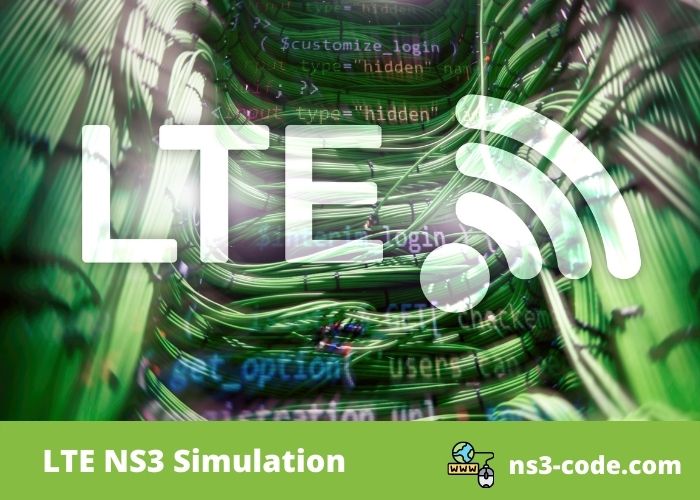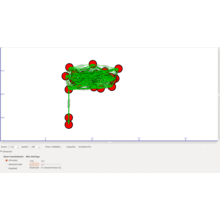The NS-3 LTE model is an application to design, simulate and test the LTE networks in a sophisticated environment. Further, this library comprises Evolved Packet Core (EPC) to improve the network performance despite the network size. For that, it supports network scalability in the following aspects.
- Different User Equipment (UEs) ranges from100s to a few 1000s
- Different eNodeB devices ranges from 10s to a few 100s
Now, we can see the purpose of LTE NS3 projects. Here, we mentioned the reason behind the rapid growth of LTE networks in wireless communication. Also, it describes the role of the performance evaluation process and proposed algorithms in the NS3 based LTE Projects

Why to use NS3 for LTE Projects?
Measures the performance accurately,
- Optimizing the end-to-end quality of experience (QoE)
- Improvising the performance of the radio-frequency (RF)
Algorithms used for,
- Smart RRM for system control and maintenance
- Enhancing spectrum allocation and access
- Efficient quality of service downlink packet scheduling
- Mitigating and minimizing the inter-cell intervention
- Analyzing the criticality in the self-organized networks (SON)
Next, we can see the flow of project execution for simulating your proposed concepts. It clearly explains to you the steps of LTE NS3 project workflow starting from the simulation infrastructure selection to the run simulation process.
How Does NS3 LTE Simulation Works?
- At first, describe the environment used for simulation
- Then, it codes for designing and simulating system model using the ns3:LteHelper.h file which is obtained from the location of src/lte/helper
- Next, configure the entities used in the model using ns3::ConfigStore Interfaces
- After that, configure the expected simulator yielded result
- At last, simulate the developed model
In addition, our experts from the development team have suggested you fundamental modules used in all the LTE NS3 projects. All these modules are predefined packages embedded in the NS3 tool for performing LTE Simulator communication processes. Based on the requirement of the project we can add more header files to the program.
Basic Simulation Model for LTE NS3
- #include <ns3/lte-module.h>
- #include <ns3/core-module.h>
- #include <ns3/mobility-module.h>
- #include <ns3/network-module.h>
For your add-on benefit, we have also given you the list of configuration parameters that are used to evaluate the simulated network. The below parameters are used to depict how the LTE model is designed at the time of the simulation.
Simulation Configuration Parameters for NS3 LTE Model
- default ns3::LteeNodeBPhy::Noise-Figure “6”
- default ns3::LteeNodeBPhy::tx-Power “25”
- default ns3::LteeNodeBDevice::Uplink-Bandwidth “30”
- default ns3::LteUePhy::tx-Power “20”
- default ns3:: LteeNodeBDevice::Uplink-EARFCN “17000”
- default ns3::LteUePhy::Noise-Figure “7”
- default ns3:: LteeNodeBDevice::Downlink-EARFCN “80”
- default ns3::LteHelper::Scheduler “ns3::Pf-Ff-Mac-Scheduler”
- default ns3:: LteeNodeBDevice::Downlink-Bandwidth “30”
- default ns3::LteHelper::PathlossModel “ns3::FriisSpectrumPropagationLossModel”
Important Design Criteria for LTE NS3
Next, we can see the basic requirements for designing LTE models using the NS3 simulation tool. For illustration purposes, here we have given you the LTE-based MAC Scheduler interfaces.
- Mode of Connection
- It assures that UE is linked up with the ECM, RRC and EMM
- Hybrid Model for Multi-Objective Control Plane
- It comprises LTE APIs for S11, X2-C and S1-C models
- It enables Realistic Radio Resource Control (RRC) protocol for backing interaction
- Granularity in Radio Wave Propagation
- It supports physical channel modeling
- It doesn’t suits for system based model since resource block is quite expensive
- Simplified Evolved Packet Core (EPC) Platform
- It includes single Serving Gateway (SGW) and Mobility Management Entity (MME) along with PDN gateway (PGW) where PWG and SGW are in the same node.
- Realistic Network Protocol Model (for Data Plane)
- It facilitates correct data transmission over IP address
- It offers end-to-end quality of experience (QoS) for system efficiency verification
- It includes S1-U, Realistic circuit, X2-U and Packet Data Convergence (PDCP) Protocol
Furthermore, our developers have given you the important metrics used in the time of performance evaluation of different layers such as MAC, Physical, RLC based on Packet Data Convergence Protocol (PDCP) level Key Performance Indicators (KPIs). Now, we can see the metrics of the Radio link control (RLC) KPI files in terms of both uplink and downlink.
NS-3 LTE Simulation Outputs
- Number of acknowledged RLC-Protocol Data Units (PDUs)
- Overall number of acknowledged bytes
- Number of transferred RLC-PDUs
- Overall number of transferred bytes
- RLC-PDU size (computed in bytes)
- Lowest value
- Average
- Highest value
- Standard deviation
- RLC-PDU Latency (measured in seconds)
- Lowest value
- Average
- Highest value
- Standard deviation
Similar to RLC files, we have also given you the metrics of the Packet Data Convergence Protocol (PDCP) KPI files in terms of both uplink and downlink. This PDCP is intended to deliver services to their Radio Resource Control (RRC) in LTE.
- Total obtained PDCP-Protocol Data Units (PDUs)
- Number of bytes obtained
- Total transported PDCP-PDUs
- Number of bytes transported
- PDCP-PDU Size (computed in bytes)
- Highest value
- Average
- Lowest value
- Standard deviation
- PDCP-PDU Latency (measured in seconds)
- Lowest value
- Average
- Highest value
- Standard deviation
In fact, the data radio bearers which are used to transmit packets among eNB and UE are applicable for PDCP but don’t produce in SM RLC. Further, the above specified PLC-PDU and PDPC-PDU have some common metrics as follows,
- Unique ID
- Logical Channel
- Cell ID
- Cell-specific (Radio Network Temporary Identifier)
- User Equipment (Mobile Subscriber Identity)
- Simulation
- Start time
- End time
Similar to RLC and PDCP files, we have also given you the metrics of the MAC KPI files in terms of both uplink and downlink. Generally, this file is stockpiled in ASCII files which are designed to assign resources based on a scheduler.
- For uplink MAC KPIs:
- TB
- MCS and Size
- TB
- For downlink MAC KPIs:
- Size
- TB 1 and TB 2
- MCS
- TB 1 and TB 2
- Size
Other common metrics of MAC KPIs uplink and downlink:
- Identity
- Cell
- Cell-specific User equipment (RNTI)
- User equipment identity (IMSI)
- Frame and Sub-frame number
- Simulation duration for resource allocation (in seconds)
So far, we have seen the metrics of MAC and PHY KPI files. Now, we can see some important APIs used in these layers to create the custom-based outcome. And they are classified and configured based on attributes.
For MAC KPIs, we have the following files,
- ns3::MacStatsCalculator::DownlinkOPFilename
- ns3::MacStatsCalculator::UplinkOPFilename
For PHY KPIs, we have the following files,
- ns3::PhyStatsCalculator::DownlinkRxOPFilename
- ns3::PhyStatsCalculator::InterferenceFilename
- ns3::PhyStatsCalculator::UplinkRxOPFilename
- ns3::PhyStatsCalculator::DownlinkTxOPFilename
- ns3::PhyStatsCalculator::UplinkTxOPFilename
- ns3::PhyStatsCalculator::UeSignal-to-Interference-plus-NoiseratioFilename
- ns3::PhyStatsCalculator::DownlinkReferenceSignalReceivedPowerSinrFilename
Similarly, in LTE RSRP (Reference Signal Received Power) / SINR (Signal to Interference & Noise Ratio) and user Equipment SINR files, we use the following metrics:
- Reference Signal Received Power (RSRP)
- Unique UE and Cell ID
- Time for simulating the system (in seconds where the distribution is performed by scheduler)
Further RSRP/SINR includes the uplink SINR which are in the linear scale of user equipment. Similarly, UE SINR includes downlink SINR for the total RB linear average. In addition, interference comprises cell identity, simulation period, and set of interfering values for each RB.
To the end, we can see the performance metrics of both uplinks (UL) and downlink (DL) transmission and reception interfaces.
- Modulation and Coding Scheme (MCS)
- Transport Block (TB) Size
- Data Transmission Layer
- Simulation Duration (measured in MS)
- Version of redundancy
- Radio Network Temporary Identifier
- Flag for specifying new data arrival
- Unique Identity for both Cell ID and User Equipment
The above-specified metrics are common for both transmission and receptions. Further, UL/DL reception contains a mode of transmission and TB reception accuracy. In some cases of LTE simulation, there may be the possibility of occurring Radio Link Failure (RLF) till the connection is established between eNB and UE. Next, we can see how the LTE NS3 project is tested during the development phase. Basically, the testing process is classified into the following categories:

How Do You Test the LTE NS3 Simulation?
- Validation tests
- Authenticate the experimental results with the conceptual context based on certain use-case performance
- Unit tests
- Analyze the one particular module and verify its functions capabilities and performance
- Valgrind Test Coverage
- Check the overall system in all their supportive frameworks
- Verify the software code errors while build the program (stable LENA code)
- Automatically validate the memory related errors such as exploitation, outflows, usages, etc.
- System tests
- Combine all the individual units into one single LTE system and test the operations
RESEARCH IDEAS IN LTE NS3
- Interference Management (Intercells)
- Packet Scheduling using QoS
- Dynamic Spectrum Sensing and Access
- RRM – LTE Radio Resource Management
Overall, we promise you that we will support both the research and code execution phases of the LTE network project. Further are you interested to know the new electrifying future directions in NS3 based LTE Network Research? Then you can find us as the best solution to meet your needs. So, make use of this opportunity and know other interesting information from us.

 Click Here to watch our latest output video using NS3 simulator
Click Here to watch our latest output video using NS3 simulator  Click Here to watch our latest projects screenshots using NS3 simulator
Click Here to watch our latest projects screenshots using NS3 simulator